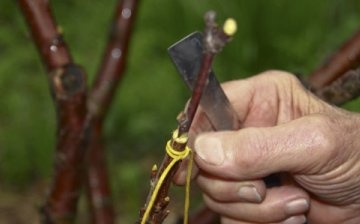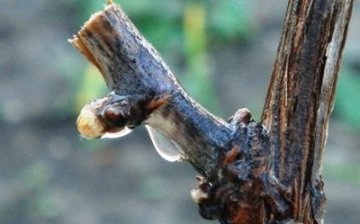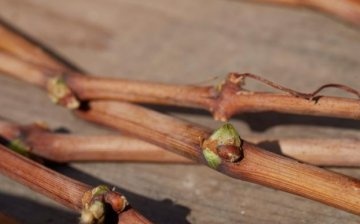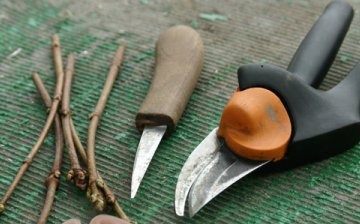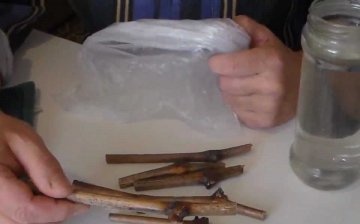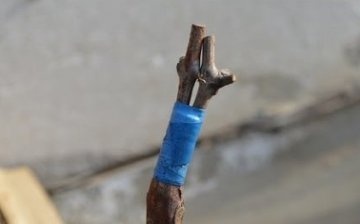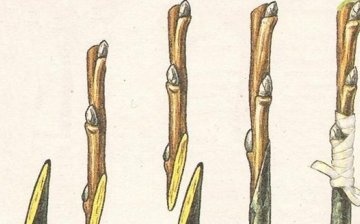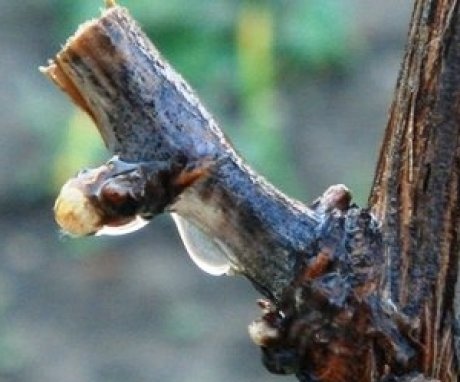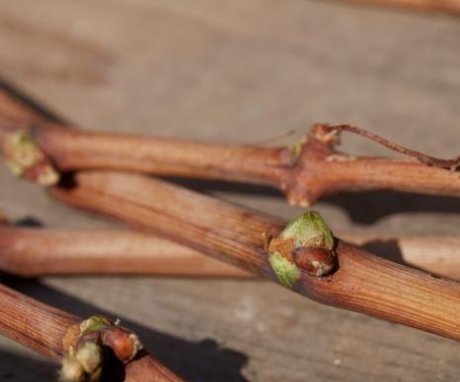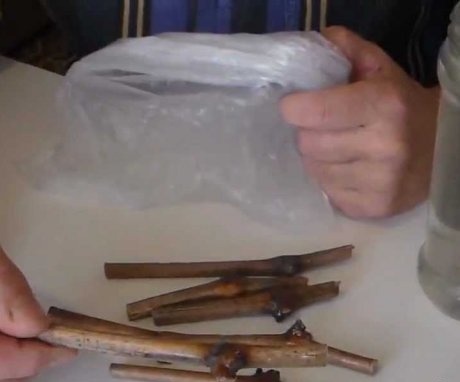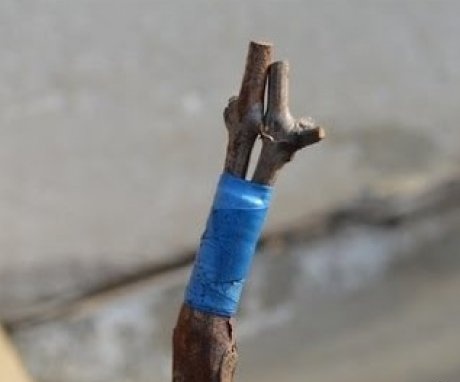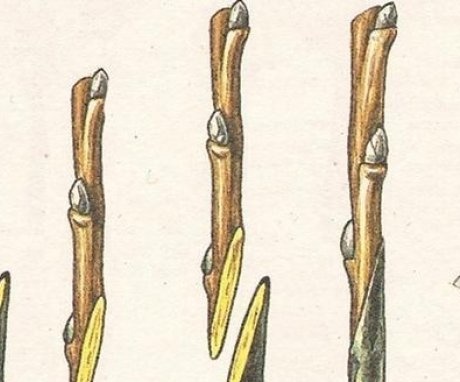Winter grafting of grapes: features and benefits
It is useful and fun to grow a good grape variety with your own hands. One of the ways to propagate a culture is by grafting.
Content
- Vaccination: the essence and meaning of the procedure
- Benefits of winter grape processing
- Preparation of material for winter grafting
- Tabletop budding: when to start?
- Winter vaccination: preparing for surgery
- Improved copulation: technology
Vaccination: the essence and meaning of the procedure
Grapes can be propagated if part of one plant is engrafted on the vine or trunk of another. The shoot that is grafted is called a scion. The grape that plays the role of the base is the rootstock.
As a result of the procedure, an organism is obtained that combines the characteristics of two different varieties. They do not mix and do not interfere with each other. The bottom is an old plant, and the top is a new one with its own characteristics.
A bush on which several different types of grapes have taken root is called a bouquet.
Vaccination is considered a tricky business. Those who were not afraid to master it, enjoy the indisputable advantages of the procedure:
- On grafted plants fruits appear earlier. The very next year after planting it will be possible to feast on the first bunches.
- High yields. The grape clusters and the berries themselves are larger.
- In some varieties, fruits begin to ripen faster.
- In this way, it is quite easy to cultivate difficult to grow, rare and scarce plant species.
- This is an opportunity completely rejuvenate the vineyard.
Rescue of bushes after mechanical injuries. Gusty wind, frost and rodents can destroy all plants. Even badly damaged grapes have a chance to revive after grafting. It is much easier than uprooting bushes and replanting the area.
The region in which the seedling grows matters. In the southern regions, grafting is a method of increasing drought resistance, prevention of phylloxera. The root system of the renewed plant is more resistant to aphids, which feed on its sap. The pest infects not only the roots, but also the leaves: the bush withers and dies.
On insufficiently drained soil of the northern regions, the procedure will help to defeat high humidity and acidity. In parallel, the period of active growth and development of the bush increases. A new plant obtained after grafting retains all its positive qualities and acquires new ones.
Benefits of winter grape processing
All plants have a period of mandatory biological dormancy (October-January) and forced (February-end of March). The development of grapes in the second period of time is hindered by unfavorable weather conditions. The bush is ready to grow, but the winter continues. The plant is waiting.
This feature of the culture is successfully used for winter grafting. The procedure is known as "table", because you have to work not in the garden, but in the room, at the table. It is an improved copulation - the connection into a single whole of the root system of one variety and the scion of another species. The new method has gained no less popularity than summer budding and spring grafting with a cuttings.
The operation, which is performed in winter, has the maximum benefits.
The disadvantages are at least.In 90-95%, the rootstock successfully grows together with the scion. The engraftment time is short. Already after 12-14 days, the result is visible: there is a chance to repeat an unsuccessful attempt.
If we compare the winter procedure and summer budding, then in the first case the period of growing seedlings... In just 1 year, instead of two, a full-fledged one-year shoot is obtained.
As a result of autumn work, almost all buds take root. However, many plants are lost in winter. They get wet, weed out or destroyed by frost.
The key to success with winter grafting are:
- Knowledge of technology.
- Good rootstocks and scions.
- Well chosen time for work.
- Carrying out stratification.
- A quality tool.
Grafting grapes with the tabletop method has advantages due to which it is gaining more and more fans.
Preparation of material for winter grafting
Cutting cuttings - an important point on which the success of the entire enterprise directly depends. Choose a ripe vine of a yellow-brown hue with a hard and dry bark. Shoots formed on a fruit vine will do. Shanks are prepared with a length of 55 cm and a diameter of 6-12 mm. They are carefully (preserving the kidneys) cleaned of antennae and stepsons. Slices are made from both ends: one is 0.5 cm below the knot, and the second is a few centimeters higher.
The cuttings can be sprinkled with sand and placed in a pit (depth 60 cm). With the arrival of severe frosts, you will have to take care of insulation.
Also, the scion is stored in polyethylene with the addition of wet sawdust. The temperature is about 00C. The stock is prepared in the fall, after waiting for the leaves to fall. The workpieces are cut so that the trunk rises 10 cm above the roots.
The ground part of the plant is treated with a weakly concentrated solution of potassium permanganate. The grapes are placed in sawdust or sand, the temperature is maintained at 00C.
As a basis for grafting, you can use seedlings or vegetatively propagated shoots... In a high-quality stock, the thickness of the bole at the junction is 7-8 mm, the length of the branched root system is from 12 to 15 cm. It is impossible to plant grapes in winter without taking proper care of the preparation of raw materials.
Tabletop budding: when to start?
The timing of grafting is determined by the type of seedlings (vegetative, lignified), which they want to get from the grafted stems or rootstock. Waiting until mid-December, they begin to work with green seedlings, the root system of which is closed in a bag or container. At this time, the buds of most plant species have already "woken up" and are ready to develop.
If vaccinations are preserved in the refrigerator, an earlier start is allowed. The beginning is postponed until the end of January, when, after grafting, stratification is planned, landing in the ground.
In general, the ideal time for the procedure is from early to mid-March.
During this period, biological processes begin to intensify, in planting material accumulated plastic elements from which callus and roots are formed. Being late is fraught with a drop in the survival rate of the parts to be joined. Raising the temperature to 6-70C leads to the fact that the grapes begin to "breathe", the supply of plastic substances is depleted.
Cuttings stored in a refrigerator (glacier) are grafted until the end of April. Work is stopped 25-30 days before planting the seedlings in a permanent place. The beginning of the procedure depends on the storage conditions of the grape harvest.
Winter vaccination: preparing for surgery
Before the very procedure of connecting different varieties, it is important prepare planting material... Neglecting this step will lead to late callus formation. The scion freed from the strapping will simply fall off the base.
Preparing cuttings:
- Remove from storage 7 days before the expected date of inoculation.
- Withstand several days in a humid environment (sawdust, moss).
- Soak for 3-4 days, immersing them in water (15-170C) for a quarter of their length. Cover the container or tie it with polyethylene.It is recommended to add bee honey to the liquid (3-5 g / l); heteroauxin (0.03-0.05 g / l).
- To strengthen weak cuttings, potassium permanganate (0.15-0.2 g / l) is dissolved in the liquid.
- An increase in temperature to 25-280C will accelerate the swelling of the eyes. At the same time, they should not be allowed to grow.
The readiness of the shank is evidenced by swollen eyes, which visually differ from the dead (subsequently removed).
The base is prepared 3-5 days earlier. Stock pretreatment:
- Shorten the growth on the grapes, leaving a few eyes.
- Update slices on the root system, preserving it as much as possible.
- Soak for 2 days in water.
- Place in boxes. There is a moisture-retaining material between the seedlings.
- Cover with foil.
- Over the course of 5-7 days, gradually increase the temperature to 22-240C.
The stock is considered ready for surgical intervention if the remaining eyes have grown to 1-1.5 cm. Seedlings that are heavily dried or frozen are reanimated by raising the temperature to 280C. Inspect such shoots after 9-10 days. An obligatory event before vaccination is the preparation of all planting material.
Improved copulation: technology
Procedure for winter grafting:
- Choose a scion and rootstock equal in diameter.
- On them with a sharp knife, cuts are made obliquely. They should be even, length - 3 cm.
- The chubuk is shortened by 2 kidneys.
- On fresh cuts of both grape varieties, cuts are made with a knife. The result will be "tongues".
- The stalk is connected to the base so that the grooves of the tongues "go" into each other, and the cambial layers coincide.
- The vaccine is hidden under polyethylene.
- The top of the cutting is processed garden pitch.
- It is recommended to apply waxing of the junction.
- The grafted culture is put in boxes and left warm for 15-20 days. Rhizomes are sprinkled with wet sawdust.
With knowledge of copulation, the plant can be successfully grafted. A not-so-good or damaged grape does not have to be uprooted. Winter grafting is a great way to bring your shrub back to life.
More information can be found in the video.



